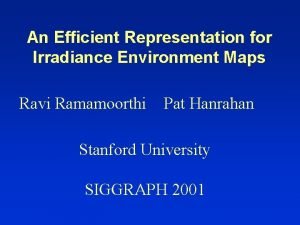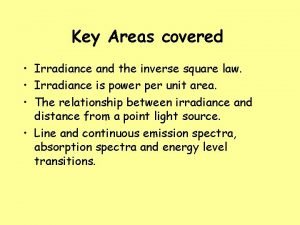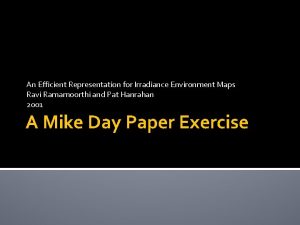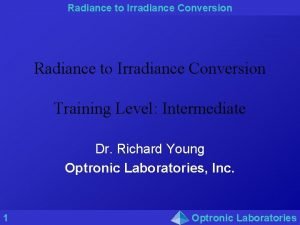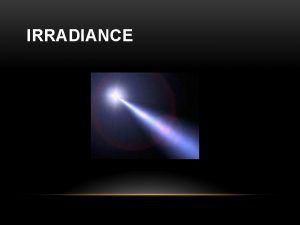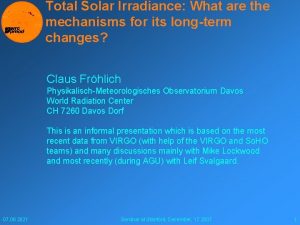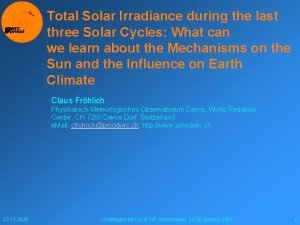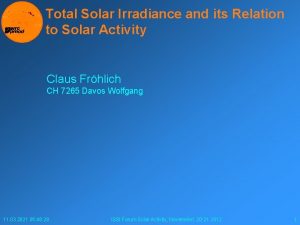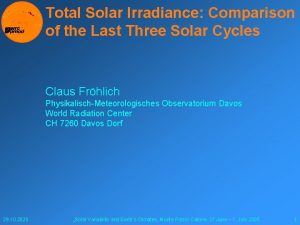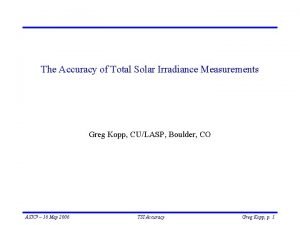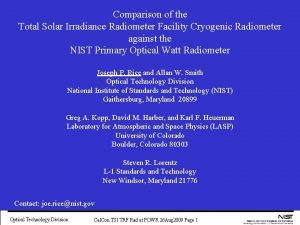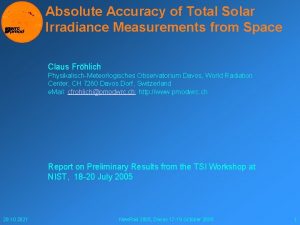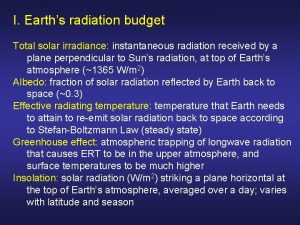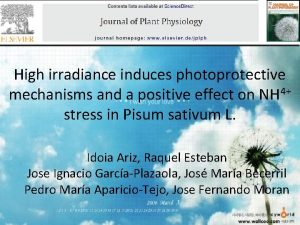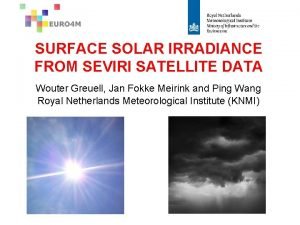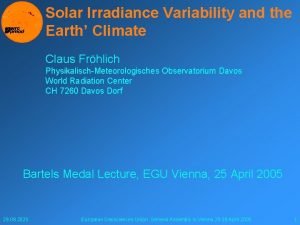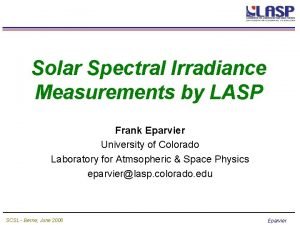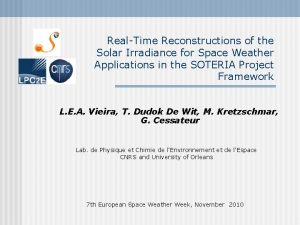Total Solar Irradiance What are the mechanisms for
























- Slides: 24

Total Solar Irradiance: What are the mechanisms for its long-term changes? Claus Fröhlich Physikalisch-Meteorologisches Observatorium Davos World Radiation Center CH 7260 Davos Dorf This is an informal presentation which is based on the most recent data from VIRGO (with help of the VIRGO and So. HO teams) and many discussions mainly with Mike Lockwood and most recently (during AGU) with Leif Svalgaard. 25. 10. 2021 Seminar at Stanford, December, 17 2007 1

TSI Database 1978 to present: What is available and which data can contribute to a composite? § § § Since 1978 reliable TSI measurements from space are available from the following overlapping missions with electrically-calibrated radiometers (ECR): • HF (Hickey-Frieden) on NIMBUS 7 (17/11/1978 - 24/01/1993) • ACRIM-I on SMM (16/02/1980 - 01/06/1989) • ERBE on ERBS (24/10/1984 - 12/03/2003) • ACRIM-II on UARS (06/10/1991 - 27/09/2001) • SOVA on EURECA (11/08/1992 - 15/05/1993) • VIRGO (PMO 6 V, DIARAD) on SOHO (07/02/1996 - ………) • ACRIM-III on Acrim. Sat (05/04/2000 – ………) • TIM on SORCE (25/02/2003 - ………) For the composite results from HF, ACRIM-I and II and VIRGO are used, with ACRIM-I as radiometric reference. ERBE data are used as an independent dataset for comparison. As its sampling is so sparse (once every 14 days for a few minutes) daily data from a proxy model are also used for interpolation between the measured ERBE points. 25. 10. 2021 Seminar at Stanford, December, 17 2007 2

TSI Database 1978 to present: What is available and which data contribute to the composite? • Note the differences in absolute scale: the 0. 5% range at the beginning has been reduced to <0. 2% for the ‘classical´ radiometers. However, the values from TIM on SORCE (in operation since February 2003) are about 4. 8 Wm-2 (0. 4%) lower. The reason for this large discrepancy is not yet understood. • Only the ACRIMs, VIRGO and TIM radiometers have back-ups for in-flight determination of degradation. • The circled time-series are those used to construct the PMOD composite. 25. 10. 2021 Seminar at Stanford, December, 17 2007 3

TSI Database 1978 to present: Corrections needed for the different TSI for the PMOD Composite The HF and ACRIM data sets need some corrections which will be illustrated in the following sequence of plots. VIRGO does not need any more corrections. These correction refer to: • ACRIM-I data need a correction for the early increase and a change in the distribution of the degradation with time (both are calculated by applying the model developed for PMO 6 V) • HF data need to be corrected for glitches due to re-orientations of the S/C and other operational effects, for the early increase, the degradation and a trend which is exposure independent (similar to DIARAD) • In ACRIM-II some glitches have been identified, two of them are due to changes of the operational radiometer. Then, its level need to be adjusted to the level of ACRIM-I (metrology). • The HF and VIRGO data have to be shifted to the level of ACRIM-I which is the radiometric reference for the PMOD composite 25. 10. 2021 Seminar at Stanford, December, 17 2007 4

TSI Database 1978 to present: Discussion of the PMOD, ACRIM and IRMB composites The composite and VIRGO data are available from ftp. pmodwrc. ch through www. pmodwrc. ch • A major result of the PMOD composite is that the Sun did not change much during the last 25 years. The only trend is the peak-to-peak amplitudes which decrease mono-tonicaly for the 3 cycles. • If the HF correction during the gap between ACRIM I and II is neglected, one gets the ACRIM composite. On the other hand, the IRMB composite is a combination of all time series reduced to SARR and the ACRIM gap is bridged via ERBS. • Comparison of all composites with ERBS shows convincing evidence for the need of the HF correction and disproves the statement that ERBS was degrading during the ACRIM gap. The ERBS data in this plot have been corrected for the early increase with the coefficients determined for ACRIM-I and the dose of ERBS (total of 2. 6 days of exposure). 25. 10. 2021 Seminar at Stanford, December, 17 2007 5

Estimation of the Uncertainty of the Composite TSI and of a Possible Trend § § § In order to asses the long-term uncertainty of the composite we may use the uncertainty of the slope of the comparison with ERBE which amounts to 4 ppm/a or 42 ppm over the time between the minima. Although this uncertainty is mainly due to the sampling noise in the ERBE data (Spearman rank =0. 773) it may be used as an upper limit. The difference in slope of the ACRIM and PMOD composite is mainly due to the corrections of ACRIM-II not considered in the ACRIM composite. The uncertainty of the HF corrections over the ACRIM gap is estimated to ca. 40 ppm. The trend determined by the difference of the two minima is – 12 ppm with a formal error of 5 ppm. The combined uncertainty of the corrections over the ACRIM gap (40 ppm) and those of ERBE comparison is about 60 ppm. Thus the trend is not significantly different from zero at the 5 level. This uncertainty of about 50 ppm over a solar cycle is astoundingly low compared to the estimated absolute uncertainty of the order of 1500 ppm. This is only possible due to the overlapping measurements from two or more simultaneous missions. Results from TIM on SORCE are lower by 0. 35% than VIRGO. It may indicate that the absolute uncertainty of the present radiometers used in space is underestimated mainly due to some effects which are not yet accounted for. 25. 10. 2021 Seminar at Stanford, December, 17 2007 6

Influence of Sunspots and Faculae § § The series of images (July 1988) illustrates the darkening of sunspots and brightening by faculae The two different effects are obvious from the histograms of the variance. The ratio of the two effects varies within the cycle. From the position of the mode of the distribution the relative contributions of sunspots and faculae can be determined. Then they can be compared to the proxy model which will be introduced next. 25. 10. 2021 Seminar at Stanford, December, 17 2007 7

Proxy Model of Irradiance Variations § § § Sunspots can be modeled from their area and position on the disk by using an appropriate contrast. The result is the photometric sunspot index (PSI) For faculae a similar approach could be applied. However, the areas are difficult to observe directly. So they have to be derived from plages, magnetograms or spot areas. Here, we use the Mg. II Index as a surro_gate for faculae and network The Mg index can be devided into short and longterm parts representing the faculae and network within and outside active regions. 25. 10. 2021 Seminar at Stanford, December, 17 2007 8

Proxy Model of Irradiance Variations § § § The model is calibrated by regression of the three components PSI, Mg. IIst and Mg. IIlt with the PMOD composite. There may be a undetected trend in the Mg. II data, so we search for by comparison with the TSI composite. For an independent comparison the F 10. 7 flux could be used. As it is influenced also by the magnetic fields of the spots we compare only during minima. From these comparison the conclusion is that there seems to be trend in TSI which is not directly explained by the megnetic effects as revealed by the Mg. II index 25. 10. 2021 Seminar at Stanford, December, 17 2007 9

Proxy Model of Irradiance Variations § The multiple regression yields the following results for the model TSI Straight: 82. 3% Best fit for all: 86. 5% F 10. 7 fit for cycle 23: 85. 3% 25. 10. 2021 Seminar at Stanford, December, 17 2007 10

Proxy Model of Irradiance Variations The coefficients of the multiple regression are different for the long and short term Mg. II: Mg. II shortterm is 93 and for the longterm 120, the difference may be explained by the difference in specific contrast of the network and faculae as shown by Ortiz (2005) from MDI data. From this it becomes evident, that the solar cycle variation is mostly determined by the network, whereas faculae only contribute to the active region variability. It could, however, also mean that we have still another component and now comes the new stuff! 25. 10. 2021 Seminar at Stanford, December, 17 2007 11

Comparison with other TSI § § § Before we go on we need to be sure that we have data representing the Sun So we need to demonstrate that trend of TSI as observed during cycle 23 is real. This is covered by VIRGO We do this by comparison of the VIRGO which covers most of cycle 23 with ACRIM II on UARS and TIM on SORCE. 25. 10. 2021 Seminar at Stanford, December, 17 2007 12

Where come the trends in TSI from? § § Mg. II index shows a strange behaviour during cycle 23 F 10. 7 is different and the minima are quite constant or vary by very small amounts The sunspot Number is similar, no trend (zero is zero!) The IMF is the only parameter which shows something similar to TSI. The cycle variation does not at all look like TSI, but the minima may. The reason may be that the base reflects the basal network amount remaining during a cycle. More thinking about the variation within a cycle is needed – see also model calculations of Baumann and Schüssler, 2006, which should be extende to cycle 20 which is quite different 25. 10. 2021 Seminar at Stanford, December, 17 2007 13

Where is Zero Magnetic Field in TSI? § § Before we go on let us have a look at Fosters Ph. D Thesis From MDI magnetograms one can determine the distribution of the radial magnetic field within an active region. From such distributions one can distinguish between faculae and network. So the facular and network contributions within an active region can be estimated separately. The remaining magnetism at solar minimum value can also be determined and extrapolated to zero magnetic field. This is the basic idea for possible long-term changes of TSI on top of the solar cycle variation 25. 10. 2021 Seminar at Stanford, December, 17 2007 14

Can we determine the sensitivity of TSI relative to changes in open field One way is to compare the long-term trends: the result is 0. 121 0. 005 Wm-2/n. T 25. 10. 2021 Seminar at Stanford, December, 17 2007 15

Can we determine the sensitivity of TSI relative to changes in open field The other way is to compare the trend between minima: the results are shown for the different cycles in the following table. The straight mean yields 0. 41 0. 26 Wm-2/n. T. If we allow for 50 ppm uncertainty for cycles 22 and 23 (in opposite directions) we get 0. 55 0. 11 Wm-2/n. T. Both ranges overlap and a reasonable estimate would be 0. 5 Wm-2/n. T. 25. 10. 2021 Seminar at Stanford, December, 17 2007 16

Long-term Changes of TSI By the way, this longterm trend is from the paper with Mike in June this year, which gave quite a bit of revolution for greenhouse sceptics – so we have a follow-up…… The point is: the temperature of the Earth increased since the seventies and the Sun does not follow this trend and thus does not seem to be responsible for this increase. This does not mean that the Sun has no influence on climate! 25. 10. 2021 Seminar at Stanford, December, 17 2007 17

How does the open magnetic field of the Sun behaved during the last century? In the famous paper of Lockwood et al. in Nature 1999 claiming that the Sun‘s magnetic field doubled during the 20 th century. How does it looks like today? The difference is now only 0. 64 n. T, compared to 1. 6 n. T. With the sensitivity we determined earlier this corresponds to a TSI value being lower by 0. 3 Wm-2 during the minimum of 1901. 25. 10. 2021 Seminar at Stanford, December, 17 2007 18

How do the values of Wang et al. compare? § § § 25. 10. 2021 The difference between 1901 and 1986 is 0. 84 n. T (just read from the graph). The difference in TSI is 0. 49 Wm-2 including the ephemeral fields. The fields from the ephemeral regions, however, are most likely included in the open field. But Judith has to take them extra as her reconstruction of the solar cycle is mostly due to active regions. So the value of the sensitivity is 0. 58 Wm-2/n. T, very similar to what we get. Seminar at Stanford, December, 17 2007 19

Reconstruction of Irradiance Variations in the Past § § § The problem with sunspot numbers as proxies surfaced with the quite different solar cycle 23 which shows no longer a very good correlation between sunspot numbers and irradiance. The short-term correlation works for the influence of sunspots, and during these strong cycles there is also a correlation between sunspots and faculae. But the variations are no longer correlated to the degree observed for cycles 21 and 22 due to the ‘Maunder Minimum’ maximum in TSI. One should certainly look for an other proxy, maybe the production function for 10 Be is better suited. 25. 10. 2021 Seminar at Stanford, December, 17 2007 20

§ § How can cosmogenic isotopes help? Rouillard et al have extrapolated the Climax data back to 1880 from their reconstructed IMF. From this the production function can be calculated and compared to the observed one which I got from Jürg Beer. This is 11 -year averaged, but higher time resolution data should be possible. We need both the amplitude and the minima! 25. 10. 2021 Seminar at Stanford, December, 17 2007 21

There is another problem of modulating TSI with magnetic fields Low-order p modes are influenced by all magnetic fields, threading the solar surface, whereas TSI sees only part of it due to the Spruit effect. 25. 10. 2021 Seminar at Stanford, December, 17 2007 22

Conclusions § § § Solar irradiance varies with the 11 -year solar cycle, being higher during solar maximum (about 0. 1% for TSI) During the last 30 years of space measurements TSI shows a decline after 1980. Comparing the minima values this is most pronounced in cycle 23. This most recent decrease cannot be explained by the changes deduced from Mg. II index or F 10. 7, but need a trend the origin of which may be reflected by the open field from the Sun. However, one has to keep in mind, that TSI sees only part of the network due to the Spruit effect – on the other hand low-order p modes are influenced by all fields the same way. Comparison with the observed radial IMF allows to determine a sensitivity of TSI of about 0. 5 Wm-2/n. T. Radial IMF can be reconstructed back to about 1880 and so can the minima of TSI. This covers the long-term changes of the minima and comparison with 10 Be production rate may be used to go further back in time. Present reconstructions of the are based on the today’s understanding of the present Sun and the behavior during the last 3 activity cycles – with the caveat that cycle 23 and somewhat lesser also 21 are different from cycle 22. The present understanding does not really allow to determine the solar cycle amplitude of TSI in the past – especially during the Maunder Minimum when 10 Be observes a cycle variation without sunspots. We must be able to distinguish between the influence of the active regions and the underlying cycle variation by e. g. the network. Sunspot numbers alone cannot do it! There is still a lot of work to be done…………. 25. 10. 2021 Seminar at Stanford, December, 17 2007 23

This the end………. Thanks 25. 10. 2021 Seminar at Stanford, December, 17 2007 24
 Insidan region jh
Insidan region jh Irradiance environment map
Irradiance environment map Inverse square law irradiance
Inverse square law irradiance An efficient representation for irradiance environment maps
An efficient representation for irradiance environment maps Vray irradiance map vs brute force
Vray irradiance map vs brute force Radiance to irradiance conversion
Radiance to irradiance conversion Wholesalesolar.com/solar panels
Wholesalesolar.com/solar panels Solar energy is free. solar is inexhaustible
Solar energy is free. solar is inexhaustible Total revenues minus total costs equals
Total revenues minus total costs equals Total revenues minus total costs equals
Total revenues minus total costs equals Activo promedio
Activo promedio Total revenue minus total expenses
Total revenue minus total expenses Total revenues minus total costs equals
Total revenues minus total costs equals Vilken grundregel finns det för tronföljden i sverige?
Vilken grundregel finns det för tronföljden i sverige? Big brother rösta
Big brother rösta Verktyg för automatisering av utbetalningar
Verktyg för automatisering av utbetalningar Sju principer för tillitsbaserad styrning
Sju principer för tillitsbaserad styrning Plats för toran ark
Plats för toran ark Kolposkopi px
Kolposkopi px Tack för att ni lyssnade bild
Tack för att ni lyssnade bild Romarriket tidslinje
Romarriket tidslinje Shingelfrisyren
Shingelfrisyren Informationskartläggning
Informationskartläggning Borstål, egenskaper
Borstål, egenskaper Vishnuiter
Vishnuiter

